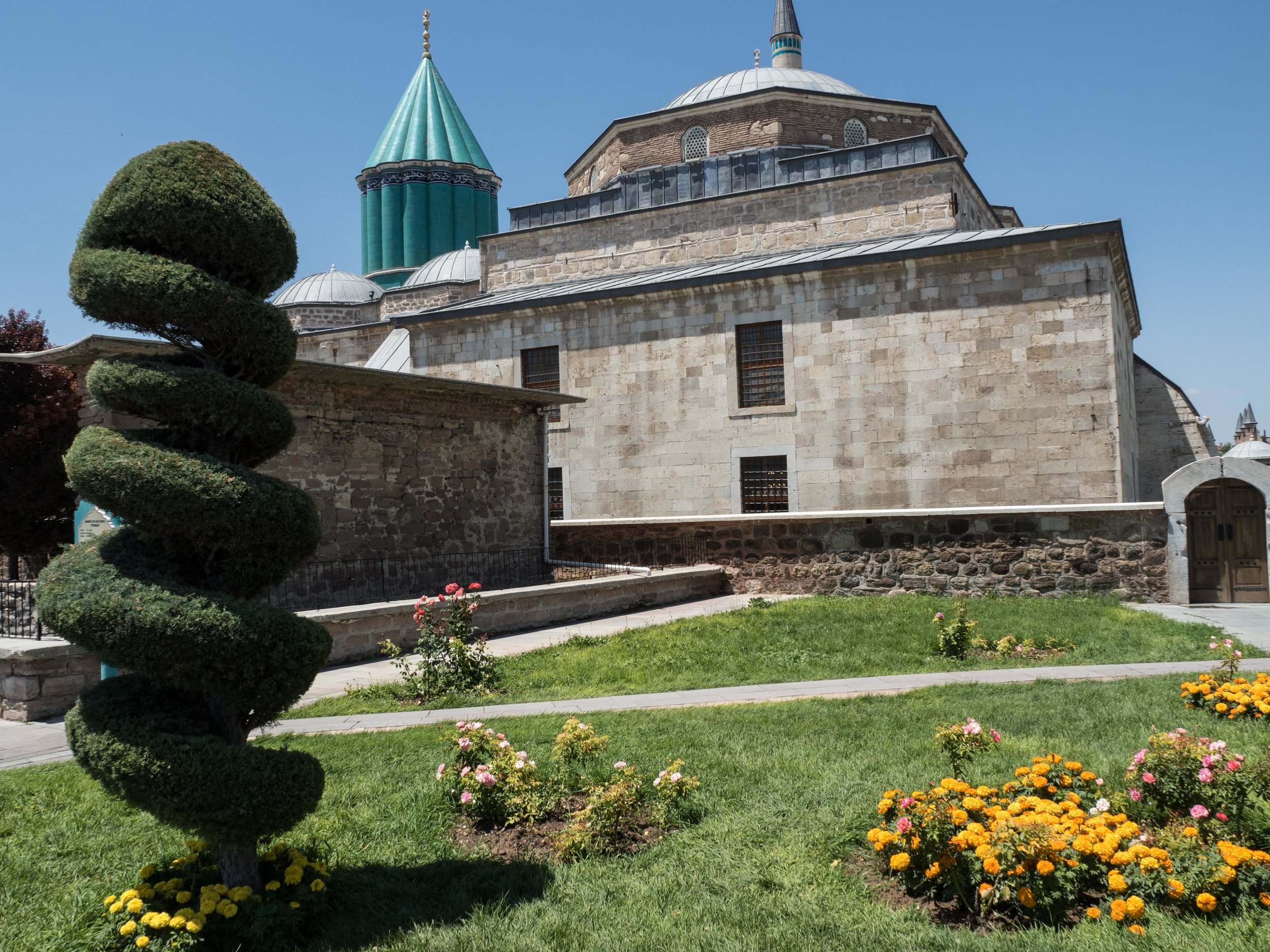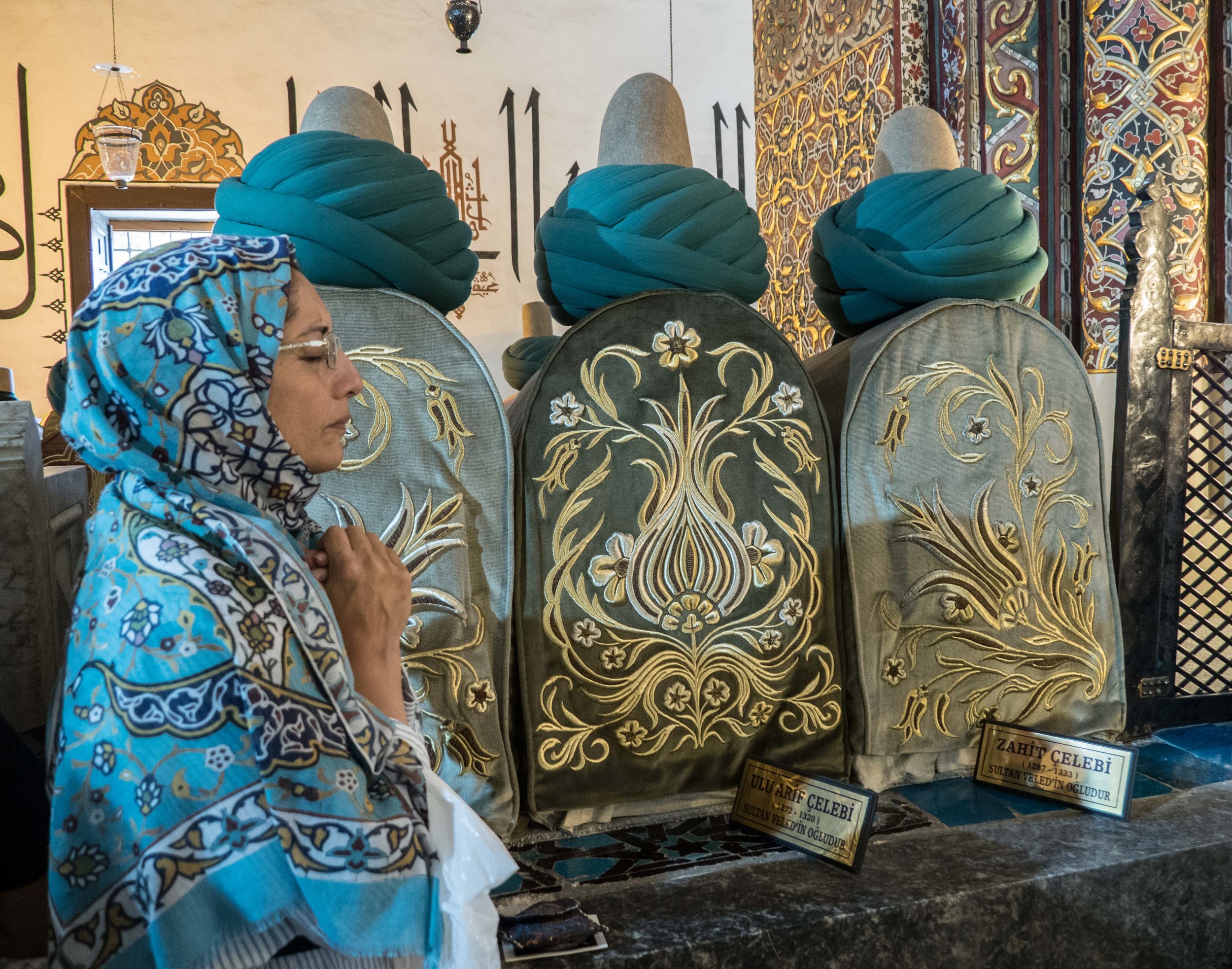Sufis are everywhere in the world. Even though they are marginalized by the two mainstream denominations of Islam (Sunni and Shiah), they have made major contributions to spreading Islam in past centuries. Sufis are the mystics of Islam, focusing on individual spirituality. Many masters have taught different ways of connecting with the divine. Music and poetry — typically not part of mainstream Islam — play a major role in many of these teachings. One of the most impressive combinations of mysticism, music, and dance is practiced by the Mevlana order founded by Rumi in Konya. These mystics have become known as the Whirling Dervishes and have become Rumi’s worldwide legacy.
It was under Ataturk in the 1925 that most of these orders and their practices were banned, but some of them survived nonetheless. In the 1990’s performances in public were allowed again, and In 2008, the performance was inscribed on the UNESCO list of Intangible Cultural Heritage of Humanity. Following that, under president Erdogan, an enormous cultural center was built in Konya to preserve this heritage. Weekly performances of these traditional dances are sponsored and open for the public.
Now therein lies a problem… Is this still a mystic tradition of individual spirituality, or has it become a mere tourist spectacle? Either way, these performances are a must-see event for any visitor, no matter where you come down on this debate.
The Turkish government also has spent untold sums in restoring the Mevlana Dervish Lodge. Between 1 and 2 Million visitors come here annually and yet, the entrance is free, both to the lodge museum and to the performances.
The lodge itself lies in the center of town and is situated in a park-like setting with several graveyards. One of them is dedicated to the mothers and wives of lodge members, another to some of Rumi’s followers, and one to the most famous Ney Players! The ney is a flute that has to be blown at a slight angle controlling the airflow just so. More about the ney later.
The grounds of the lodge are immaculately groomed and filled with “scissorhand”-like trimmed shrubs. One could tour the kitchen of the lodge and the cells in which the lodge members lived. Members were not like monks, confined to the lodge until death, but typically spent 1001 initiation days there, and then returned to family and work life on the outside. Today, these cells mainly function as small exhibition spaces. Some demonstrate lodge life by displaying mannequins in their original settings (cell or kitchen). It was almost a surprise to see a live member reciting the Koran. He looked like a mannequin himself.
Aside from the above-mentioned graves, there are some full-scale free-standing tombs and a sacred well. But the main attraction is the mosque with the adjacent indoor tomb area — placed under the iconic green cone-shaped dome. Richly decorated tiled walls form the square chamber around Rumi’s large sarcophagus. Various other lodge dignitaries and some of Rumi’s relatives are buried here as well. A white or green turban is placed on each tomb and the rank of the deceased can be determined by the number of wraps that make up the turban.
Single file, and picture-snapping, the crowd moves passed these tombs. Some devout visitors stop to pray in the presence of Rumi before moving on to the museum part. Once again, a case with yet another beard of Mohammed drew most of the attention.
You should plan your visit to make sure to catch a whirling dervish performance. I had come early to the event and stumbled on a group of students learning the ney from a ney master who also is a ney flute maker. I watched them for quite a while from the sidelines and then was brave enough to ask, if I could give it a try. They humored me. The teacher grabbed an instrument, gave me a demonstration on how to angle and blow, and then left me to my devices. I am a Western flute player, grew up with the recorder, and was already ahead of the curve. I can control different air flows and play with different angles and embouchures. But even after 10 minutes of trying, I could not get a note out of that flute! That taught me some respect for this simple-looking instrument.
The master assured me that this was quite normal. In fact, he said, that it takes a musician about 10 years to become comfortable with it, 20 years to become very good at it, and 30 or 40 years before they are considered to master it. Wow. Such a little wooden flute and such a challenge; truly incredible.
At the Cultural Center there is an outdoor auditorium, there are conference halls, commercial souvenir stands, and a humongous indoor auditorium. It must be big enough to hold thousands. We, the audience that night, did not even fill it half way.
The whirling dervish performance is standardized. Everything, from the steps, the arm gestures, the music, the clothing, to the prayers, has meaning. The biggest difference is the number of performers. There can be just a few, or as in our case, almost 40. The setting at the Culture Center lent itself to dramatize the dance by using different light and sound effects. And there we go again — is this still a meditative dance, or a full-blown show? Well, it was a show.
In addition to the setting, you take the audience who of course has to videotape and snap pictures (some with flash!), and then it’s definitely a show. The woman sitting next to me made three (!) phone calls during the show. I shot glances at her for the first two times and finally slapped her arm-rest when she would not stop. She seemed surprised that I was upset.
Despite the unfitting setting and the unruly audience, this was an amazing experience. I had seen a small performance in Istanbul the last time around, but this was different as it was here, in the heart of Rumi’s town and performed with such a large group of dervishes.
I was moved. But I would not go quite as far as one woman in my hotel, a tourist from Europe, who would not stop gushing about how she could just feel the spiritual vibes of Konya… Perhaps she can. I could not.
But I like Konya a lot. And Rumi seems to have been a cool guy worth knowing and remembering.



















